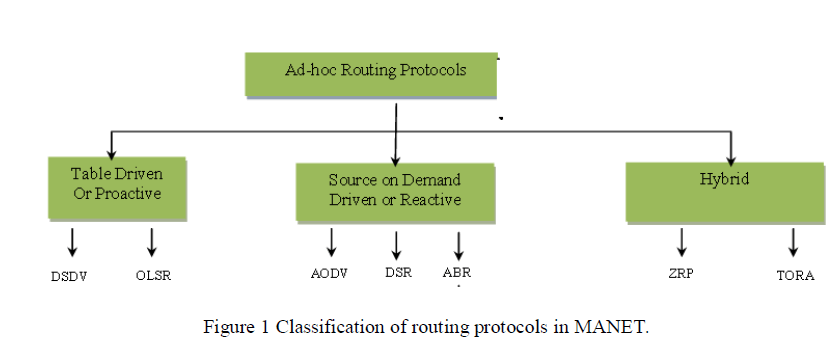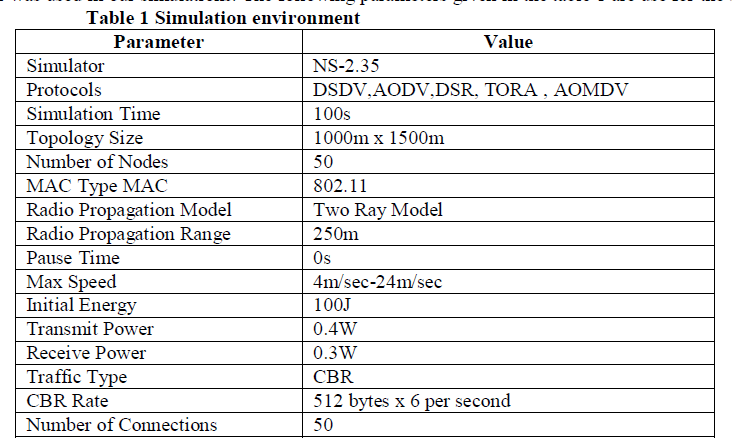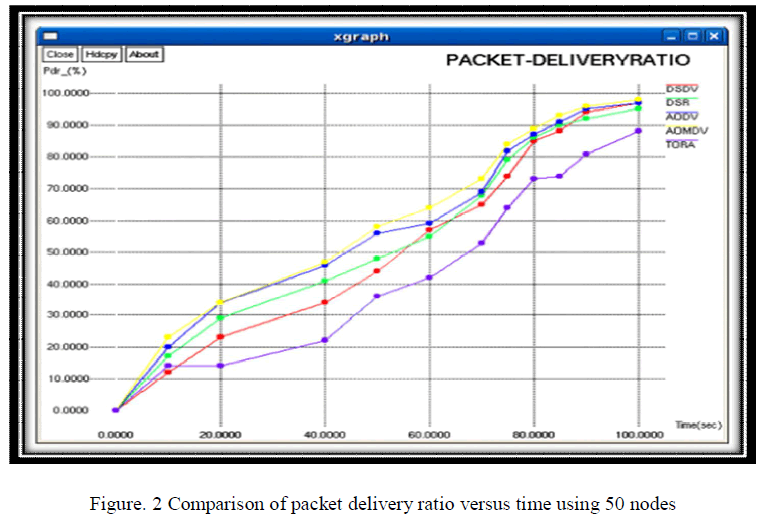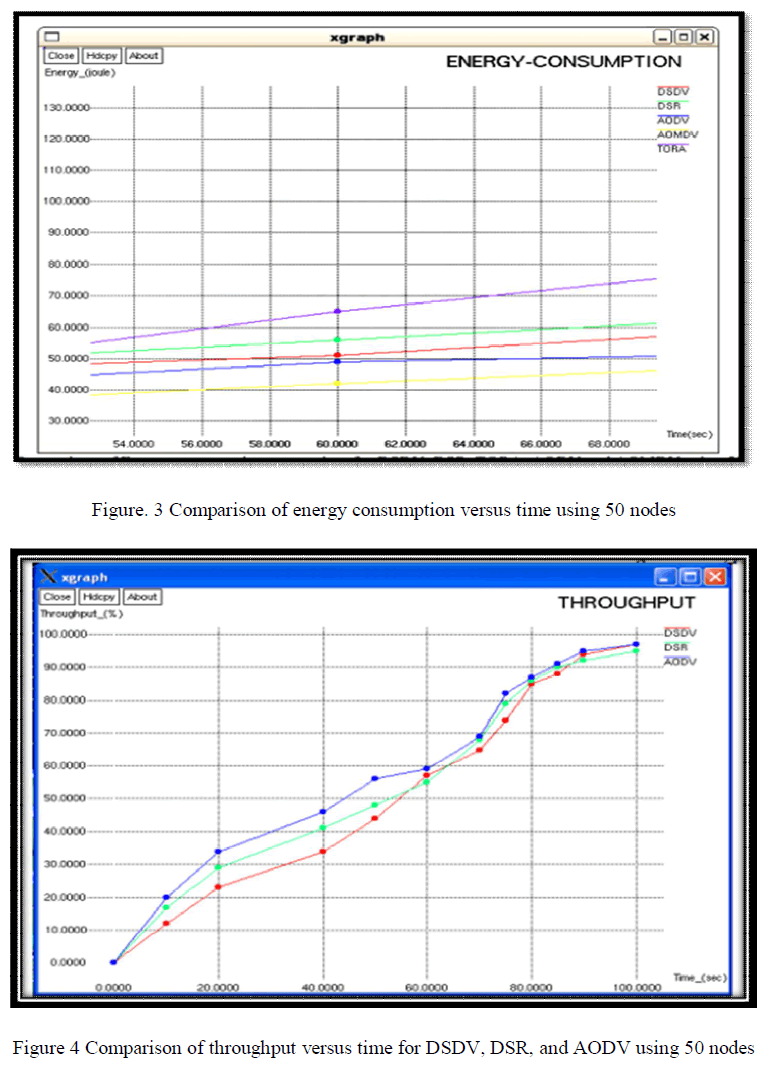Keywords
|
| AOMDV, MANET, DSDV, DSR, packet delivery ratio, throughput. |
I.INTRODUCTION
|
| Mobile Ad-hoc Network (MANET) is one that comes together as needed, not necessarily with any support from the existing infrastructure or any other kind of fixed stations. This is mainly due to the mobility of nodes. The nodes in the network not only act as hosts but also as routers that route data to or from other nodes in network. In mobile ad-hoc networks a routing procedure is always needed to find a path so as to forward the packets appropriately between the source and the destination. Various protocols have been developed for adhoc networks such as DSDV (Destination- Sequenced Distance Vector), DSR (Dynamic Source Routing), AODV (Ad-Hoc on Demand Routing), TORA (Temporally Ordered Routing Algorithm) and AOMDV (Ad hoc on-demand Multipath Distance Vector Routing). These protocols offer varying degrees of efficiency. This paper aims to find out an energy efficient routing protocol. It also aims to limit power consumption of mobile nodes in the network in order to prolong the network life time. The main objective of this paper is to analyze AOMDV protocol for ways it could be improved. This can be done by measuring energy with respect to network size and taking into consideration the remaining battery power [1]. This paper evaluates the performance of various adhoc routing protocols such as DSDV, AODV, DSR, TORA and AOMDV in terms of energy efficiency and showed that AOMDV is better in comparison with all the above protocols. The simulation is carried out using network simulator NS-2.35 under Linux platform. The performance metrics used for evaluation are packet delivery ratio, throughput, and energy consumption. |
II. RELATED WORK
|
| Routing Protocol is used to find valid routes between communicating nodes. They do not use any access points to connect to other nodes [1]. It must be able to handle high mobility of the nodes. Routing protocols can be mainly classified into 3 categories |
| -Centralized versus Distributed |
| -Static versus Adaptive |
| -Reactive versus Proactive |
| In centralized algorithms, all route choices are made by a central node, while in distributed algorithms, the computation of routes is shared among the network nodes. In static algorithms, the route used by source destination pairs is fixed regardless of traffic condition. It can only change in response to a node or link failure. This type of algorithm cannot achieve high throughput under a broad variety of traffic input patterns. In adaptive routing, the routes used to route between source-destination pairs may change in response to congestion. |
| A. ROUTING PROTOCOLS |
| The existing routing protocols in MANETs can be classified into three categories. Figure 1 shows the classification along with some examples of existing MANET protocols. |
 |
| a) Proactive (Table-Driven) Routing Protocols |
| In this family of protocols, nodes maintain one or more routing tables about nodes in the network. These routing protocols update the routing table information either periodically or in response to change in the network topology. The advantage of these protocols is that a source node does not need route-discovery procedures to find a route to a destination node. On the other hand the drawback of these protocols is that maintaining a consistent and up-to-date routing table requires substantial messaging overhead, which consumes bandwidth and power, and decreases throughput, especially in the case of a large number of high node mobility. There are various types of Table Driven Protocols: Destination Sequenced Distance Vector routing (DSDV), Wireless routing protocol (WRP), Fish eye State Routing protocol (FSR), Optimized Link State Routing protocol (OLSR), Cluster Gateway Switch Routing protocol (CGSR), Topology Dissemination Based on Reverse Path Forwarding (TBRPF). |
| b) Reactive (On-Demand) Routing Protocols |
| For protocols in this category there is an initialization of a route discovery mechanism by the source node to find the route to the destination node when the source node has data packets to send. When a route is found, the route maintenance is initiated to maintain this route until it is no longer required or the destination is not reachable. The advantage of these protocols is that overhead messaging is reduced. One of the drawbacks of these protocols is the delay in discovering a new route. The different types of reactive routing protocols are: Dynamic Source Routing (DSR), Ad-hoc On-Demand Distance Vector routing (AODV), Adhoc On-demand Multipath Distance Vector Routing Algorithm (AOMDV) and Temporally Ordered Routing Algorithm (TORA). |
| c) Hybrid Routing Protocols |
| Both of the proactive and reactive routing methods have some advantages and shortcomings. In hybrid routing a combination of proactive and reactive routing methods are used which are better than the both used in isolation. It includes the advantages of both protocols. As an example facilitate the reactive routing protocol such as AODV with some proactive features by refreshing routes of active destinations which would definitely reduce the delay and overhead so refresh interval can improve the performance of the network and node. These protocols can incorporate the facility of other protocols without compromising with its own advantages. Examples of hybrid protocols are Zone Routing Protocol, Hazy Sighted Link State [3]. |
III. PERFORMANCE METRICS
|
| A. Simulation Parameters |
| The simulators measured the following noteworthy statistical performance metrics: |
| 1. Packet delivery ratio |
| It is the ratio of the data packets delivered to the destinations to those generated by the sources. |
| 2. Energy consumptionThis is the ratio of the average energy consumed in each node to total energy. |
| 3. Throughput |
| The throughput metric measures how well the network can constantly provide data to the sink. Throughput is the number of packets arriving at the sink per ms. |
| B. Simulation Environment |
| Ns-2 simulator was used in our simulations. The following parameters given in the table 1 are use for the simulation. |
 |
| The following are the observations from the above graphs |
| 1. The energy consumption of networks using AOMDV is minimum compared to TORA, AODV, DSR and DSDV. 3. The packet delivery ratio of the networks using AOMDV is better compared to than TORA, AODV, DSR and DSDV |
IV. RESULTS
|
| Figure 2 shows the comparison of Packet delivery ratio versus time for DSDV, DSR, TORA, AODV and AOMDV using 50 nodes. It shows that the packet delivery ratio of the networks using AOMDV is better compared to than AODV, TORA, DSR and DSDV. TORA has a poor packet delivery ratio than all the other protocols. |
 |
| Figure 3 shows the Comparison of Energy consumption versus time for DSDV, DSR, TORA, AODV and AOMDV using 50 nodes. It shows that the energy consumption of networks using AOMDV is minimum compared to TORA, AODV, DSR and DSDV. TORA is consuming the maximum energy. AODV is consuming lesser energy than TORA, DSR and DSDV. Figure 4 shows the comparison of throughput versus time for DSDV, DSR and AODV protocols using 50 nodes. It shows that AODV throughput is maximum than DSDV and DSR. |
 |
IV CONCLUSION
|
| In this paper the performance of Proactive, Reactive and Hybrid routing protocols such as, AOMDV, AODV, DSDV, TORA and DSR in MANET in different network environments is evaluated. AOMDV is analyzed as the best protocol compared to AODV, TORA, DSR and DSDV when energy efficiency is taken into consideration. More research is needed to combine and integrate some of the protocols presented in this paper to keep MANETs functioning for a longer duration. |
References
|
- Lijuan Cao Teresa Dahlberg Yu Wang, „Performance Evaluation of Energy Efficient Ad Hoc Routing ProtocolsâÃâ¬ÃŸ Conference Proceedings of theIEEE International Performance, Computing, and Communications Conference 2007 IPCCC 2007: 306-313
- S. Singh, M. Woo, and C. Raghavendra, “Power-aware routing in mobile ad hoc networks,” in MobiComâÃâ¬ÃŸ98: Proceedings of the 4th annualACM/IEEE international conference on Mobile computing and networking. New York, NY, USA: ACM Press, 1998, pp. 181–190
- Jaya Jacob, V.Seethalakshmi „Performance Evaluation of Various Routing Protocols in MANETâÃâ¬ÃŸ© 2011 Journal Anu Books, Research Cell: AnInternational Journal of Engineering Sciences ISSN: 2229-6913 Issue Dec. 2011, Vol. 5
- V. Kanakaris*, D. Ndzi and D. Azzi., Ad-hoc Networks Energy Consumption: A review of the Ad-Hoc Routing Protocols, Journal ofEngineering Science and Technology Review 3 (1) (July 2010)
- DhirajNitnaware, Ajay Verma, Energy Constraint Node Cache Based Routing Protocol for Adhoc Network, International Journal of Wireless &Mobile Networks, Vol.2, No.1, February 2010
- S. Giannoulis, C. Antonopoulos, E. Topalis, S. Koubias, ZRP versus DSR and TORA: A comprehensive survey on ZRP performance, IEEETransactions on Industrial Informatics Vol. 3, No. 1, pp. 63-72 (Feb. 2007).
- D. Maltz, Y. Hu, The Dynamic Source Routing Protocol for Mobile AdHoc Networks, Internet Draft, Available:http://www.ietf.org/internetdrafts/draft-ietf-manet-dsr-10.txt, July 2004.
- C. Perkins and E. Royer, Ad Hoc On-demand Distance Vector (AODV) Routing, Internet Draft, MANET working group, draft-ietf-manetaodv05.txt, March 2000.
- H. Abd Rahman, Z. A. Zukarnain, Performance Comparison of AODV, DSDV and I-DSDV Routing Protocols in Mobile Ad Hoc Networks,European Journal of Scientific Research Vol. 31, No. 4, pp. 556-576 (June 2009).
- L. Junhai, X. Liu, Y. Danxia, Research on multicast routing protocols for mobile ad-hoc networks, Science Direct Vol. 52 Issue 5, pp. 988-997(April 2008).
- Marco Fotino and Floriano De Rango, „Energy Issues and Energy aware Routing in Wireless Ad-hoc NetworksâÃâ¬ÃŸ, University of Calabria, Italyin Mobile Ad-Hoc Networks: Protocol Design
- Shiva Prakash, J. P. Saini, S. C. Gupta „A review of Energy Efficient Routing Protocols for Mobile Ad Hoc Wireless NetworksâÃâ¬ÃŸ inInternational Journal of Computer Information Systems,Vol. 1, No. 4, 2010.
- D.Kim, J. Garcia-Luna-Aceves, K. Obraczka, J.-C. Cano, and P. Manzoni,“Routing mechanisms for mobile ad hoc networks based on theenergy drain rate,” IEEE Transactions on Mobile Computing, vol. 2,no. 2, pp. 161–173, 2003.
|